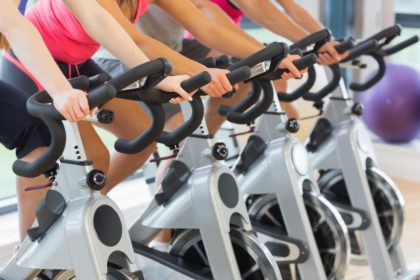 Your metabolism is the rate at which all the chemical reactions in your body work as a whole to create the energy you need to thrive. Think of your metabolism as the engine in your car. Sometimes it can be a high performance machine, but without good care, it can run like a slug. Here are some tips to keep your body working at optimum speed.
Your metabolism is the rate at which all the chemical reactions in your body work as a whole to create the energy you need to thrive. Think of your metabolism as the engine in your car. Sometimes it can be a high performance machine, but without good care, it can run like a slug. Here are some tips to keep your body working at optimum speed.
Signs of a Sluggish Metabolism
The most obvious signs that your metabolism has plummeted are:
- Weight gain
- Inability to lose weight despite restricting calories
- Fatigue
- Not feeling hungry
Causes of a Deaccelerating Metabolism
The main reasons your metabolism may be slowing down:
- Age: Your metabolism is thought to slow about one to two percent per decade.
- Low percentage of muscle mass: When your muscle mass diminishes, your basal metabolic rate (the number of calories you burn while at rest) diminishes as well.
- Not eating enough food! Insufficient calories can cause you to go into “starvation mode” which can slash
 your metabolic rate. Severely restricting your caloric intake is one of the key reasons that diets don’t work and wind up making you fatter in the end.
your metabolic rate. Severely restricting your caloric intake is one of the key reasons that diets don’t work and wind up making you fatter in the end. - Lack of exercise and physical activity: In a UC Davis study, they found that the resting metabolic rate in highly trained runners was reduced by 7 to 10 percent when daily exercise training was stopped.
- Dehydration: Your organs need water to function every day. When you don’t get enough water, your organs will slow down and can eventually shut down.
- Hypothyroidism: The main purpose of the thyroid hormone is to keep your engine running. When your thyroid isn’t producing enough thyroid hormone, your metabolism will slow down.
How to Preserve Your Metabolism
To ensure a healthy metabolism:
- Get “real” food: For your engine to perform optimally, you need to consume whole, unprocessed fuel. Get Real Food!™
- Eat regularly: Listen to your physiological signs of hunger.
- Strength train: Include exercises that make muscle, i.e., strength training. Muscle is more metabolically active that uses energy and burns calories while stored fat uses very little energy. In other words, people who have more lean body mass have a higher metabolism than those with more body fat. According to the Centers for Disease Control, strength training can increase your metabolic rate by as much as 15 percent.
- Move: Avoid sitting most of the day. Try to get in at least 10,000 steps per day. Exercises that promote good joint health, i.e., they increase your flexibility and mobility, will enable your body to move more. You’ll be able to move muscles and joints through their full range of motion. A 16-week Tufts University program found that strength training increased mobility in older adults with moderate to severe knee osteoarthritis and decreased pain by 43 percent.
- Exercise smart: Include interval training in your exercise regimen. High-intensity interval training increases your oxygen consumption and makes your mitochondria work harder. Mitochondria are organelles within your cells that produce energy from glucose and oxygen. Be sure to change up your exercise routine because your body, and thus your metabolism, adapts to the stresses placed on it.
- Balance activity with rest: Being physically active may burn more calories, but your body (especially your heart!) needs rest to perform optimally and to prevent musculoskeletal injury. How active can you be if you’re injured?
- Daily cold exposure: In a study published in the Journal of Clinical Endocrinology and Metabolism found that two hours of daily
 exposure to cold (10ºC or 50ºF) increased the amount of metabolically active brown adipose tissue (BAT) or ‘brown fat’. Mammals contain two types of fat (adipose tissue) – brown fat and white fat. The main function of brown fat is to transfer the energy from the food you eat into heat whereas white fat’s main purpose is to store energy for when fuel is needed.
exposure to cold (10ºC or 50ºF) increased the amount of metabolically active brown adipose tissue (BAT) or ‘brown fat’. Mammals contain two types of fat (adipose tissue) – brown fat and white fat. The main function of brown fat is to transfer the energy from the food you eat into heat whereas white fat’s main purpose is to store energy for when fuel is needed.
Foods that Boost Metabolism
Foods that help build muscle and offset muscle loss will help increase your metabolism which will speed up the rate at which you burn calories (and ultimately, lose weight if desired). The top seven foods include:
- Egg whites (they’re loaded with protein and vitamin D)
- Clams, lean meat or iron-fortified cereal: An iron deficiency can impair muscle function, normal function of the nervous and immune systems, and can limit your work capacity during exercise.
- Water
- Milk (a good source of calcium)
- Whole grains (these foods are rich in fiber and take more effort to break down than white bread/pasta)
- Lentils (good source of fiber and iron)
 Hot peppers (think hot sauce, cayenne and chilis). Chili peppers contain capsaicin, a chemical compound that can raise body temperature and kick up your metabolism by using up more energy. Capsaicin is likely increasing the activity of your sympathetic nervous system which activates the “fight or flight response” and the secretion of adrenaline.
Hot peppers (think hot sauce, cayenne and chilis). Chili peppers contain capsaicin, a chemical compound that can raise body temperature and kick up your metabolism by using up more energy. Capsaicin is likely increasing the activity of your sympathetic nervous system which activates the “fight or flight response” and the secretion of adrenaline. CH-19 Sweet Peppers (mild, sweet chili peppers, such as Japanese shishitō peppers): If you don’t like the heat, capsaicin’s non-burning cousin, DCT or dihydrocapsiate, found in CH-19 sweet peppers may be equally effective for boosting metabolism according to researchers at the UCLA Center for Human Nutrition. Several hours after consuming the test meal in the study, energy expenditure was almost double in the group consuming the highest amount of DCT versus the placebo group. In another study at Kyoto University in Japan, CH-19 sweet peppers were found to increase body temperature and energy consumption in healthy volunteers versus those that ate Sweet California Wonder Peppers (bell peppers) which contain neither capsaicin nor capsiate.
CH-19 Sweet Peppers (mild, sweet chili peppers, such as Japanese shishitō peppers): If you don’t like the heat, capsaicin’s non-burning cousin, DCT or dihydrocapsiate, found in CH-19 sweet peppers may be equally effective for boosting metabolism according to researchers at the UCLA Center for Human Nutrition. Several hours after consuming the test meal in the study, energy expenditure was almost double in the group consuming the highest amount of DCT versus the placebo group. In another study at Kyoto University in Japan, CH-19 sweet peppers were found to increase body temperature and energy consumption in healthy volunteers versus those that ate Sweet California Wonder Peppers (bell peppers) which contain neither capsaicin nor capsiate.
![]() Karen’s Fit Tip: Remember… you’re not stuck with a sluggish metabolism. You may not be able to bypass the slow-mo effects of aging, but with exercise of sufficient frequency, intensity and duration, the right foods, and adequate calories, you can take control of your metabolism and stop agonizing over every calorie.
Karen’s Fit Tip: Remember… you’re not stuck with a sluggish metabolism. You may not be able to bypass the slow-mo effects of aging, but with exercise of sufficient frequency, intensity and duration, the right foods, and adequate calories, you can take control of your metabolism and stop agonizing over every calorie.
xo


